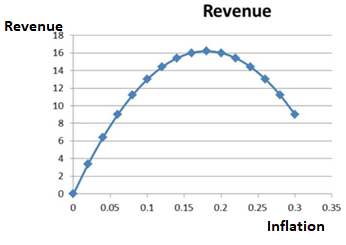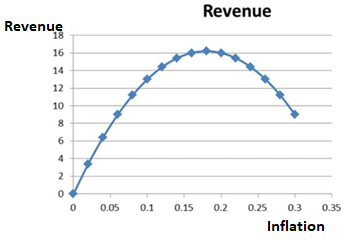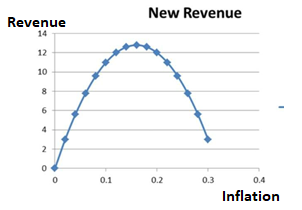
a)
To plot:Graphical representation of inflation rates.
a)
Answer to Problem 8NP

Explanation of Solution
Given Information:
Given the following information:
L = 0.2Y-500i
L = M/P
Y = 1000
r = 0.04
i = r + inflation(p)
Where,
i is the nominal interest rate
r is the real interest rate
M is the nominal money supply
L is the real money
Substitute the value of nominal interest rate into the equation of real money demand to get:
Since at equilibrium L = M/P, therefore,
Formula to calculate seignorage revenue is:
Substituting equation (1) in the above equation to get
Plotting the above equation for values of p = 0, 0.02, 0.04...0.3 in the form of a graph gives the following:
Table-1
| Inflation | Revenue |
| 0 | 0 |
| 0.02 | 3.4 |
| 0.04 | 6.4 |
| 0.06 | 9 |
| 0.08 | 11.2 |
| 0.1 | 13 |
| 0.12 | 14.4 |
| 0.14 | 15.4 |
| 0.16 | 16 |
| 0.18 | 16.2 |
| 0.2 | 16 |
| 0.22 | 15.4 |
| 0.24 | 14.4 |
| 0.26 | 13 |
| 0.28 | 11.2 |
| 0.3 | 9 |

Introduction:
Inflation is the persistent increase in
b)
Inflation rate that maximizes seignorage.
b)
Answer to Problem 8NP
Inflation rate that maximizes seignorage is 0.18.
Explanation of Solution
Given Information:
L = 0.2Y-500i
L = M/P
Y = 1000
r = 0.04
i = r + inflation(p)
Where,
i is the nominal interest rate
r is the real interest rate
M is the nominal money supply
L is the real money demand
| Inflation | Revenue |
| 0 | 0 |
| 0.02 | 3.4 |
| 0.04 | 6.4 |
| 0.06 | 9 |
| 0.08 | 11.2 |
| 0.1 | 13 |
| 0.12 | 14.4 |
| 0.14 | 15.4 |
| 0.16 | 16 |
| 0.18 | 16.2 |
| 0.2 | 16 |
| 0.22 | 15.4 |
| 0.24 | 14.4 |
| 0.26 | 13 |
| 0.28 | 11.2 |
| 0.3 | 9 |
As it can be seen from the above table, value of seignorage revenue gets maximized at the inf1ation rate of 0.18.
Introduction:
Inflation is the persistent increase in price level over a short period of time.
c)
Maximum amount of seignorage revenue.
c)
Answer to Problem 8NP
The maximum amount of seignorage that is earned is 16.2 units.
Explanation of Solution
Given Information:
L = 0.2Y-500i
L = M/P
Y = 1000
r = 0.04
i = r + inflation(p)
Where,
i is the nominal interest rate
r is the real interest rate
M is the nominal money supply
L is the real money demand
| Inflation | Revenue |
| 0 | 0 |
| 0.02 | 3.4 |
| 0.04 | 6.4 |
| 0.06 | 9 |
| 0.08 | 11.2 |
| 0.1 | 13 |
| 0.12 | 14.4 |
| 0.14 | 15.4 |
| 0.16 | 16 |
| 0.18 | 16.2 |
| 0.2 | 16 |
| 0.22 | 15.4 |
| 0.24 | 14.4 |
| 0.26 | 13 |
| 0.28 | 11.2 |
| 0.3 | 9 |
The maximum amount of seignorage that is earned is 16.2 units by referring to above table.
Introduction:
Total revenue is calculated by multiplying price into Quantity. It is the sale amount which is earned.
d)
Graphical representation of inflation rates, maximum value of inflation and revenue when Y = 1000 and r 0.08.
d)
Answer to Problem 8NP
Revenue of seignorage is maximized (at the value of 12.8) at inflation rate of 0.16.
Explanation of Solution
Given Information:
L = 0.2Y-500i
L = M/P
Y = 1000
r = 0.08
i = r + inflation(p)
Where,
i is the nominal interest rate
r is the real interest rate
M is the nominal money supply
L is the real money demand
At equilibrium L = M/P, therefore,
For Y = 1000 and r = 0.08 gives the result as:
Table-2
| Inflation | New Revenue |
| 0 | 0 |
| 0.02 | 3 |
| 0.04 | 5.6 |
| 0.06 | 7.8 |
| 0.08 | 9.6 |
| 0.1 | 11 |
| 0.12 | 12 |
| 0.14 | 12.6 |
| 0.16 | 12.8 |
| 0.18 | 12.6 |
| 0.2 | 12 |
| 0.22 | 11 |
| 0.24 | 9.6 |
| 0.26 | 7.8 |
| 0.28 | 5.6 |
| 0.3 | 3 |

Revenue of seignorage is maximized (at the value of 12.8) at inflation rate of 0.16.
Introduction:
Inflation is the persistent increase in price level over a short period of time.
Want to see more full solutions like this?
- Answerarrow_forwardM” method Given the following model, solve by the method of “M”. (see image)arrow_forwardAs indicated in the attached image, U.S. earnings for high- and low-skill workers as measured by educational attainment began diverging in the 1980s. The remaining questions in this problem set use the model for the labor market developed in class to walk through potential explanations for this trend. 1. Assume that there are just two types of workers, low- and high-skill. As a result, there are two labor markets: supply and demand for low-skill workers and supply and demand for high-skill workers. Using two carefully drawn labor-market figures, show that an increase in the demand for high skill workers can explain an increase in the relative wage of high-skill workers. 2. Using the same assumptions as in the previous question, use two carefully drawn labor-market figures to show that an increase in the supply of low-skill workers can explain an increase in the relative wage of high-skill workers.arrow_forward
- Published in 1980, the book Free to Choose discusses how economists Milton Friedman and Rose Friedman proposed a one-sided view of the benefits of a voucher system. However, there are other economists who disagree about the potential effects of a voucher system.arrow_forwardThe following diagram illustrates the demand and marginal revenue curves facing a monopoly in an industry with no economies or diseconomies of scale. In the short and long run, MC = ATC. a. Calculate the values of profit, consumer surplus, and deadweight loss, and illustrate these on the graph. b. Repeat the calculations in part a, but now assume the monopoly is able to practice perfect price discrimination.arrow_forwardThe projects under the 'Build, Build, Build' program: how these projects improve connectivity and ease of doing business in the Philippines?arrow_forward
 Macroeconomics: Private and Public Choice (MindTa...EconomicsISBN:9781305506756Author:James D. Gwartney, Richard L. Stroup, Russell S. Sobel, David A. MacphersonPublisher:Cengage Learning
Macroeconomics: Private and Public Choice (MindTa...EconomicsISBN:9781305506756Author:James D. Gwartney, Richard L. Stroup, Russell S. Sobel, David A. MacphersonPublisher:Cengage Learning Economics: Private and Public Choice (MindTap Cou...EconomicsISBN:9781305506725Author:James D. Gwartney, Richard L. Stroup, Russell S. Sobel, David A. MacphersonPublisher:Cengage Learning
Economics: Private and Public Choice (MindTap Cou...EconomicsISBN:9781305506725Author:James D. Gwartney, Richard L. Stroup, Russell S. Sobel, David A. MacphersonPublisher:Cengage Learning Economics (MindTap Course List)EconomicsISBN:9781337617383Author:Roger A. ArnoldPublisher:Cengage Learning
Economics (MindTap Course List)EconomicsISBN:9781337617383Author:Roger A. ArnoldPublisher:Cengage Learning
 Exploring EconomicsEconomicsISBN:9781544336329Author:Robert L. SextonPublisher:SAGE Publications, Inc
Exploring EconomicsEconomicsISBN:9781544336329Author:Robert L. SextonPublisher:SAGE Publications, Inc Essentials of Economics (MindTap Course List)EconomicsISBN:9781337091992Author:N. Gregory MankiwPublisher:Cengage Learning
Essentials of Economics (MindTap Course List)EconomicsISBN:9781337091992Author:N. Gregory MankiwPublisher:Cengage Learning





